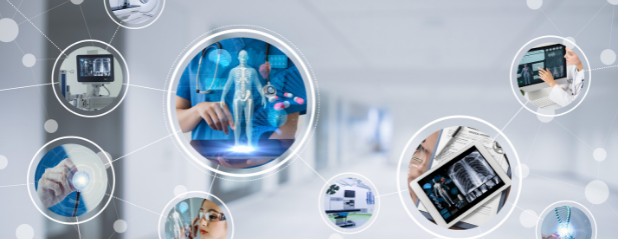5 ways technology is used in healthcare

Technology is developing every industry in today’s world, from education to automation and especially within healthcare. To help accelerate digital transformation within healthcare, the UK Government has announced an investment of £260m to enhance research and development. Up to £200m of which will be invested to facilitate research to improve access to NHS data leveraging, Trusted Research Environments, and digital trial services. Here a just a few of the ways technology is advancing the healthcare industry:
1. AI in healthcare
AI-based robots are being used to collect, store, and analyse large amounts of data to help better understand patient insights. AI is being used for the early detection of diseases, analysing breast cancer screening scans and assessing patients with potential Parkinson’s. The earlier a condition can be diagnosed, the better the chance of treatment being successful therefore AI developments will help to save a lot of lives.
Another example of AI in technology is wearable technology, this includes electronic devices that can detect physical movement, changes in body temperature, blood pressure, and much more.
2. VR in healthcare
Virtual Reality is being used in healthcare in multiple ways. One of the most used applications of VR is for pain control, which is also known as distraction therapy. The use of VR can help a patient be less focused on pain and anxiety. Whether it’s for during labour, chemotherapy, or for lower back pain, patients can put on a VR headset and find themselves in a more calming environment.
VR is also being used for medical training. VR is one of the most immersive and interactive forms of educational tools. It allows medical students to enter real life simulations, and without causing any risk or harm to people.
3. Technology Enabled Care Services (TECS)
TECS includes telehealth, telecare, and telemedicine all of which enable healthcare providers to deliver medical services through an electronic means of communication.
Telehealth means being able to provide healthcare electronically. From remote patient monitoring, healthcare employee training to counselling, using apps to review lab results and requesting repeat prescriptions from the pharmacy.
Telecare refers to the technology that allows vulnerable or elderly people to live at home unassisted. It includes remote patient monitoring, emergency medical alarms, and video services all of which can help professionals check whether the patients have had a fall, if they have breathing difficulties, a change in blood pressure, or a change in their heartbeat.
Telemedicine involves using video communication to allow patients to be seen virtually by healthcare professionals. It means they can be seen regardless of geographical location, or if they are unable to travel. This is frequently used for follow-up visits, management of chronic conditions, medication management, and specialist consultations.
4. Robot-Assisted Surgery
Robotic surgery is currently carried out using the da Vinci surgical system. The system gives the surgeons advanced instruments to help carry out advanced minimally invasive procedures. Some benefits include:
- Allowing surgeons to control instruments while sitting at a special console away from the patient's side.
- View details up to ten times more closely, and at a high resolution due to its unique 3D vision system.
- Move instruments in different directions (degrees of freedom), due to EndowristTM technology. Improving the surgeon's dexterity, making the surgery much easier.
- Allows for smaller incisions on patients meaning they will have quicker recovery time.
5. 3D Printing in healthcare
3D Printing can be used in multiple ways within healthcare, particularly when it comes to surgery. 3D printing enables surgeons to print models that are personalised for each patient, which can help with the following:
- Increases the surgery success rate, as 3D models can help provide more detailed information for the surgeon to plan and practice the surgery, minimising the risk of error.
- Speeds up procedure times as patient-specific instruments can be used
- Speeds up patient recovery times, as the 3D models are designed especially for the patient and therefore their body adapts to it quicker.
All of which reduces costs for both the hospital and the patients.
All of these technologies require skilled IT and Tech professionals, and as the industry continues to advance and develop the demand will continue to grow.
Click here to view NHS IT Jobs
